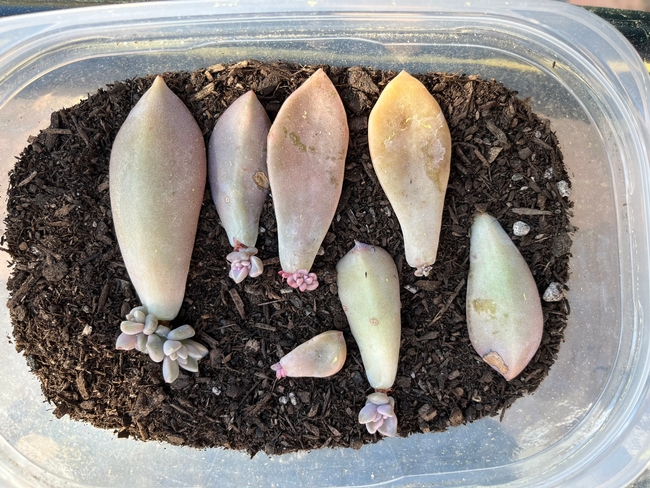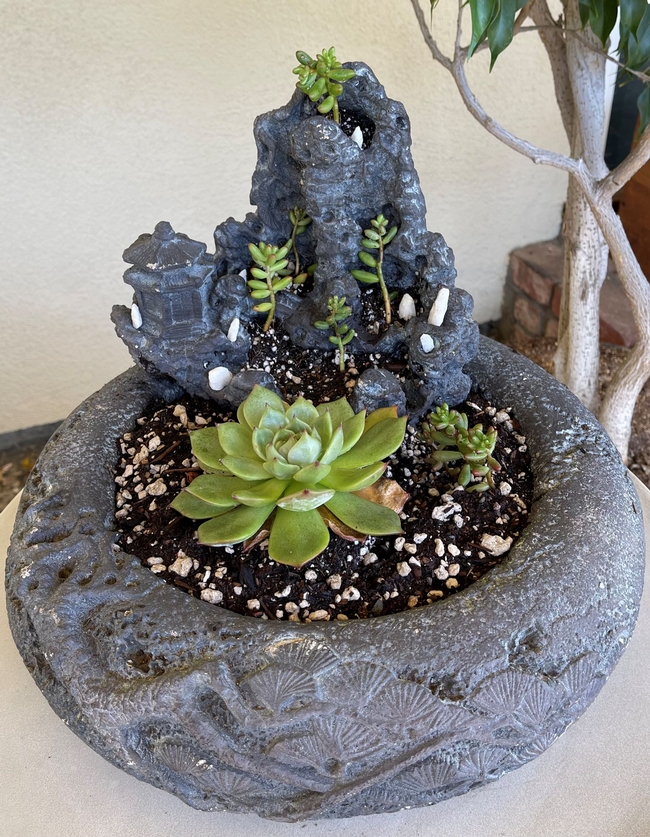Contents:
- Home Gardeners Are Important Keepers Of Biodiversity
- Growing Succulents is Easy and Fun
- Fruit Tree Pruning
- Add a Splash of Citrus to Your Yard
Home Gardeners Are Important Keepers Of Biodiversity
by Hillie Salo
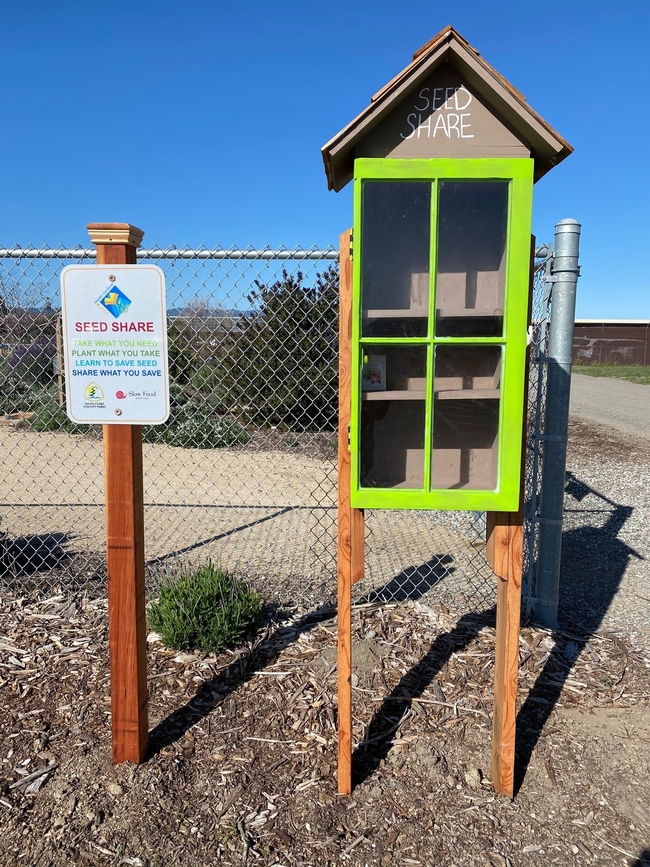
What's important about diversity? Similar to your financial assets, where it is recommended to have a diverse portfolio, a diverse gene pool affords greater protection in times of crisis; if one individual fails, diversity will allow for the survival of others and the species.
Saving and sharing seeds is an important step towards building, strengthening, and preserving this biogenetic diversity. Individually, we each have a very small gene pool, probably not much larger than the palm of your hand or a small seed packet. But together, a community can create a much larger gene pool preserving greater diversity.
Seed saving and sharing is so important that it has warranted a note by the CA legislature: “Noncommercial seed sharing activity contributes significant value to the health of our communities and the resilience of our food system.”
Seed sharing opportunities can be found at your local Seed Library. The basic idea behind Seed Libraries is seeds are “checked out” and planted in the garden. Successful plants are let go to seed. The seed is collected, and then a portion is returned to the Seed Library, ready to be planted by future gardeners, thus creating a circle of seed saving and seed sharing in your local community. This process builds genetic diversity and gives access to locally grown seeds. Those seeds may be adapted to local conditions increasing their ability to survive and produce. Common bean seeds have been shown to exhibit signs of adaptation within three years.
Local Seed Libraries can be found at many city public libraries, including San Jose Public Libraries at the Almaden, Berryessa, Calabazas, Tully, and Willow Glen branches, as well as the Santa Clara City Library, Mountain View Public Library, and Santa Clara County Library, Gilroy branch. If your search for a seed library does not reveal one at your local library, you might like to suggest that one be added to their services. Every community can benefit from a Seed Library, even and especially school libraries.
More info:
- Home Gardens: Neglected Hotspots of Agro-Biodiversity and Cultural Diversity, ResearchGate
- Homegardens in a micro-regional scale: contributions to agrobiodiversity conservation in an urban-rural context, Ethnobiology and Conservation
- Biodiversity in residential gardens: a review of the evidence base, Biodiversity and Conservation
- Food Gardens for a Changing World, UC Food Observer
- Seeds of change? Social practices of urban community seed sharing initiatives for just transitions to sustainability, The International Journal of Justice and Sustainability, Volume 27, 2022 - Issue 6
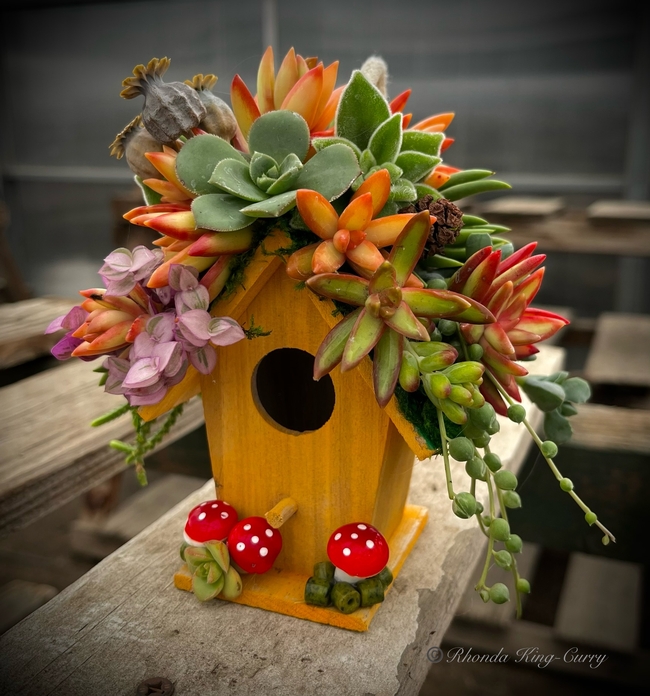 Growing Succulents is Easy and Fun
Growing Succulents is Easy and Fun

by Angie Chiappa
Succulents are plants with thick fleshy stems and leaves that collect and store water. They come in all shapes and sizes, many quite dramatic with beautiful flowers. They are also very easy to grow and are adaptable to many environmental conditions. Although sun loving, often just very good light is enough for them to grow. You can grow them in the ground or in pots, inside or outside. If they have air circulation and good drainage, they can be grown among other types of drought tolerant plants. If you are a new gardener or struggle to grow plants, succulents are for you! All cactus plants are succulents, but not all succulents are cacti. Many succulents do not have thorns and instead have rosettes, fleshy leaves, tall and thin, short with small leaves, and all sizes and shapes in between.
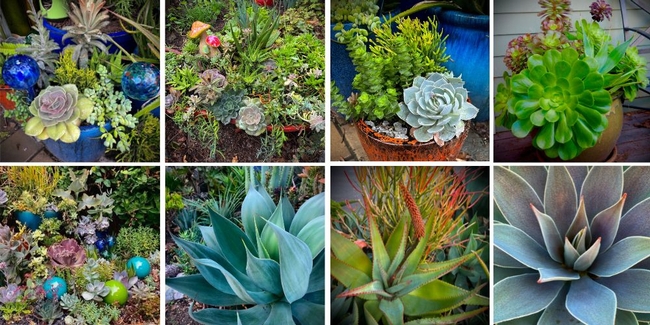
Photos: assorted succulents, by Rhonda King-Curry
Like all plants, succulents have a particular growing season. Propagate or replant winter-growing succulents in the fall and summer-growing succulents in the spring. The growing season is not necessarily the time of flowering. The flowers can appear before, during, or after the growing season.
About soil: The Master Gardeners succulent group at Martial Cottle Park in San Jose uses regular potting soil and mix in pumice.
About propagation: Propagate using a small plant piece and stick it directly in the soil after the cut dries. If there are no roots, do not water much. When the roots show, then you can water. Another way to propagate very fleshy leaves is to lay them on a slightly damp bed of soil. See the photo below.
Caring for succulents has one big rule: DON'T OVER WATER.
Water deeply once, then let it dry out. Throwing a little water on top every day will not make the plant thrive. When in doubt, DON'T water. Too much water rots the crown and stems, thereby killing the plant.
If the succulent shrivels from lack of water, it can be revived just by watering it.
The amount of sun, size and type of containers, location (outdoors or indoors) and temperatures (close to freezing or very hot), determine when to water and whether the plant will thrive.
Succulents close to dying can be revived with some care and experimentation. If you receive a half-dead succulent snippet or an item decorated with succulents, cut off the dead parts and try growing the healthy snippet. You may be surprised and end up with a nice plant!
Looking for some succulents? The Master Gardeners succulent group sells succulents on the third Saturday of every month, from 9 am–noon at Martial Cottle Park. There are hundreds of plants to choose from. We hope to see you there.
The succulents webpage on our website has more info.
Below is a repurposed tabletop water fountain decorated with succulents. A good idea during a drought when every drop of water is precious. Also, it's a great time to grow succulents during a drought.
More info:
- Succulents and Cacti, El Dorado Master Gardeners
- Growing Succulents, Santa Clara Master Gardeners
- Propagation of Cacti & Succulents, Ernesto Sandoval talk at the 2017 Convention of the Cactus and Succulent Society of America, YouTube
- Cacti and succulents identification, plantsam.com
Fruit Tree Pruning
by Amanda Crooks
The time to prune dormant fruit trees is here. With the exception of apricot and cherry trees, winter is the best time to prune most deciduous fruit trees. Apricot and cherry trees should be pruned in the summer, when there is a higher chance of no rain for 6 weeks after pruning, to reduce the risk of Eutypa dieback.
Here are some general pruning tips.
- Gather your tools
- Hand pruning shears
- Lopping shears with 24–30" handles
- A folding or fixed handled pruning saw, with 8–15" curved blades and wide set teeth
- Make sure the blades are sharp to cut as cleanly as possible. Dull blades can leave rough cuts and increase the potential for disease or pests to affect the tree.
- When deciding which branch to cut and where to cut it, keep in mind:
- Topping a vertical branch encourages vegetative growth and opens the tree to more sunlight.
- Topping a horizontal branch renews fruiting wood and thins out excessive fruit. Horizontal branches left uncut will bear earlier and heavier crops.
- Do most of the pruning in the top of the tree so that the lower branches are exposed to sunlight. Branches exposed to sun will remain fruitful and produce the largest fruit. Shaded branches will eventually stop fruiting.
- Remove suckers, water sprouts, and most competing branches that grow straight up into the tree. Also remove any downward-bending branches.
- Tree-specific guidelines on how much to prune:
- For peach and nectarine trees, remove about 50% of last year's growth.
- For fig, apple, pear, plum, and apricot trees, remove about 20% of last year's growth.
- For cherry trees, only prune in the first 5 years of the tree's life, focusing on creating a proper structure with an open center and adequate spacing between scaffold branches.
- Try to prune when there is little to no rain in the forecast. Rain shortly after pruning can increase the risk of disease and pests affecting the tree.
- If you have a “fruit salad” tree with multiple varieties grafted onto a single tree, prune only the tips of branches in the summer to avoid removing all grafted material.
- Research does not support the use of wound sealing or tree sealant materials on pruning cuts; leave them exposed to the air after pruning.
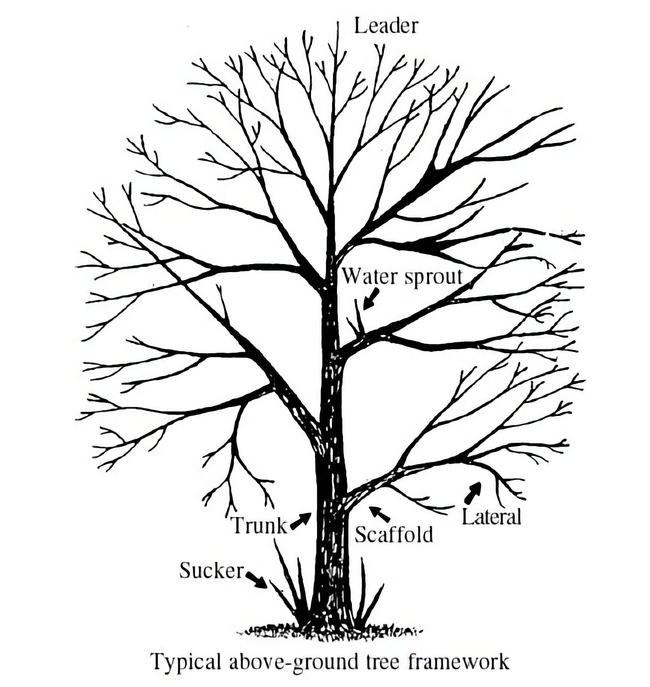
Illustration: Virginia Cooperative Extension
If you have any overgrown or neglected fruit trees in your yard, it is possible to revive them through pruning. However, it's important to note that if fruit production is your goal, it may be best to replace the tree with a new one. Some things to keep in mind when trying to prune an overgrown fruit tree:
- It can take two to three years to prune a neglected fruit tree adequately enough to encourage fruit production.
- Focus on rejuvenating the tree into one that is structurally sound, functional, manageable, and attractive.
- A few large pruning cuts accomplish more than many small cuts. Avoid over-pruning.
- Stand back frequently and look at the tree several times to visualize where to prune and the future structure you desire.
More info:
- Eutypa dieback, UC Integrated Pest Management
- Pruning and Training, UC ANR Publication 8058
- Reviving Neglected Fruit Trees, UC ANR Publication 8058
Add a Splash of Citrus to Your Yard
By Karen Seroff
Let's talk about citrus! Besides being a wonderful source of vitamin C, citrus fruits are often used for garnishes, for adding a bright flavor to culinary dishes, and even displayed in a bowl to add color to a kitchen. Their fragrant blossoms are attractive to people and pollinators alike. Citrus are evergreen plants that can live and produce fruit for many years. They can be grown as a bush or shaped into a tree form as they grow taller, or even espaliered, adding beauty and interest to your landscape.
But what citrus plants grow best in Santa Clara County? Do they need special care to be productive? Let's explore a few of the varieties of citrus that are recommended for our area and how to best care for them.
Some recommended citrus varieties for Santa Clara County:
- Oranges: Lane's Late Navel, Valencia, Washington Navel, Robertson's Navel, Trovita, Cara Cara
- Blood Orange: Moro
- Sour Oranges: Chinotto, Seville, Bergamot, Bouquet de Fleurs
- Mandarins: Clementine, Dancy, Fremont, Kara, Kinnow, Page, Satsuma, Encore, Nova, Shasta Gold
- Grapefruit: Oro Blanco (grapefruit/pomelo hybrid)
- Lemons: Eureka, Lisbon, Meyer, Pink, Improved Meyer (free of tristeza virus)
- Limes: Bearss
- Kumquats: Meiwa, Nagami
- Tangelos: Minneola
- Unusual Citrus Varieties:
- Buddhas Hand Citron
- Makrut Lime (Thai or Indonesian Lime)
- Kumquat hybrids-Limequat, orangequat, and calamondin
Many other varieties may also do well in Santa Clara County. The above list is based on UC Master Gardener trials, taste tests, and feedback from local growers.
Where to Plant: Citrus will do best if planted in a sunny, warm location. Southwestern exposure or a location near a patio or driveway will maximize natural and reflected warmth. Avoid planting citrus in a lawn or near areas where they will receive excessive water.
When to Plant: Although citrus can be planted at any time of the year, the best time is after the last frost in spring (mid-March to April).
Planting Instructions: Dig the planting hole slightly less deep than the root ball and twice as wide. Avoid adding amendments, as the tree will grow best in native soil. Plant with the root ball about one inch above the surrounding soil for good drainage. Create a watering basin around the plant, sloping down away from the trunk. Trunk sunburn can be prevented by painting the trunk with white interior latex paint diluted 1:1 with water. Add a 3–4 inch layer of mulch around the tree to conserve moisture and reduce weeds. Make sure mulch is at least 6 inches away from the trunk. Citrus can also be planted in containers. Look for naturally smaller trees. Use at least a 15-gallon container. Water when the top 2–3 inches of soil is dry, and fertilize once or twice a month. Be prepared to transplant to a larger container when it becomes necessary.
Harvesting Citrus Fruit: The first 3–4 years after planting a citrus tree are considered “nonbearing” years. There may be some light fruit production, but most of the plant's energy is used in developing root and branch growth. Trees will often drop some fruit and may be alternate bearing (heavy crop one year, light crop the next). It is important to let the fruit develop on the tree, as it won't continue to ripen once picked. Tasting fruit periodically will help indicate when it is best to pick. Color is not always a good indicator of ripeness.
Freeze Concerns: Citrus trees are subtropical to tropical in nature. Therefore, freezing temperatures can cause severe damage and possibly even death of the plant. You can help protect your citrus by watering several days before an expected freeze and draping the tops of citrus trees with blankets or plastic. Remove the covering once the weather warms up to prevent the trees from overheating.
More Information:
- Growing Great Citrus, Santa Clara County Master Gardeners
- Citrus Cultural Tips, Pests and Disorders, UC Integrated Pest Management
- Citrus, The California Backyard Orchard, UC ANR
- Frost Protection for Citrus and Other Subtropicals, UC ANR Publication 8100
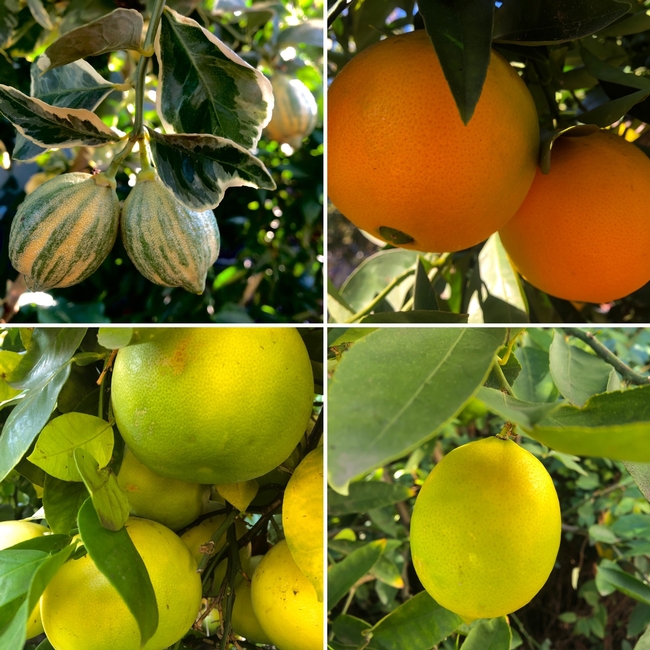
Photo (clockwise from top left): 'Pink Lemonade' lemon, Washington Navel Orange, Bearss Lime, and 'Oro Blanco' Grapefruit, by Rhonda King-Curry


